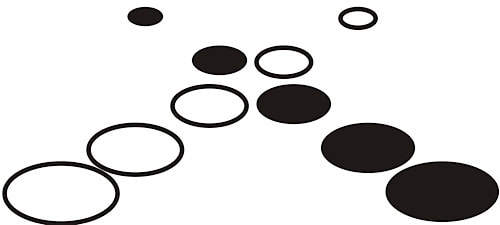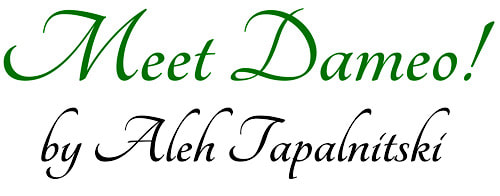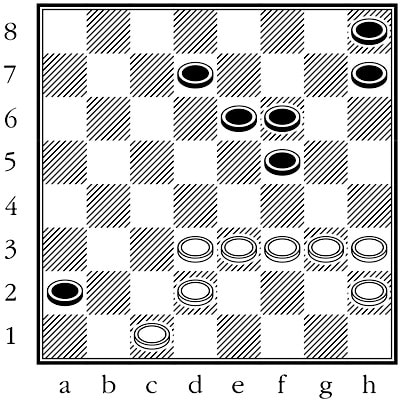Book review
Dameo is Christian Freeling's attempt to perfect checkers, We discussed Dameo in AG10, with some problems in AG11. Aleh Tapalnitski is a checkers expert from Minsk in Belarus. His small book, Meet Dameo!, is available as a free PDF and is published on Christian Freeling's Mindsports website. Meet Dameo! is one of those rare contributions to the world of abstract gaming, in that it is devoted entirely to a single game. Of course, there are thousands of books on Chess, or Go, or Bridge, for example, but among the relatively little known modern abstract games the new fan often has very little to go on. Other examples of this genre are Bill Leighton's Mastering Tak, Level 1: A foundation for success and Randy Ingersoll's Play Hive like a Champion, both discussed in AG17. We should cherish these works as labours of love that bring some of the higher concepts of their games within easy reach for new players.
Aleh's book contains the rules of Dameo and twelve succeeding sections in which he discusses some key concepts. Players of Anglo-American Checkers or International Checkers will recognize many of these ideas, which include the Royal Hit, the Turkish Hit, the Trap Door, and so on. It is interesting and significant that much of the theory of checkers is common to multiple checkers variants. The same is true of course with concepts like Fork and Pin across the chess variants, but I think checkers is special in the multitude and complexity of ideas that are present in corresponding ways in various forms of the game. Among the checkers variants, nevertheless, Dameo is special in the low incidence of its drawn games. Even a small advantage can be converted into a win, because two Kings always defeat one King.
Following his presentation of these important concepts, Aleh gives 14 problems rated from 1 to 5 in terms of their level of difficulty. Lastly, he presents three complete games annotated in considerable detail. Throughout the book, in fact, Aleh's analysis is clear and easy to follow.
I asked Aleh how he became so knowledgeable about this relatively new game, because after all I think nothing like this has ever been done for Dameo. Aleh, it turns out, is a very strong amateur player of International Checkers, who became disillusioned with the drawishness of his game, where even three Kings usually can do no more than draw against one King. He tried Frisian Checkers (AG10), which, like Dameo, overcomes the drawishness of International Checkers, but found the method of capture "... quite difficult for the eyes to perceive and not very beautiful." In any case, says he managed to reach his current level of expertise one year after coming to Dameo. He comments,
Aleh's book contains the rules of Dameo and twelve succeeding sections in which he discusses some key concepts. Players of Anglo-American Checkers or International Checkers will recognize many of these ideas, which include the Royal Hit, the Turkish Hit, the Trap Door, and so on. It is interesting and significant that much of the theory of checkers is common to multiple checkers variants. The same is true of course with concepts like Fork and Pin across the chess variants, but I think checkers is special in the multitude and complexity of ideas that are present in corresponding ways in various forms of the game. Among the checkers variants, nevertheless, Dameo is special in the low incidence of its drawn games. Even a small advantage can be converted into a win, because two Kings always defeat one King.
Following his presentation of these important concepts, Aleh gives 14 problems rated from 1 to 5 in terms of their level of difficulty. Lastly, he presents three complete games annotated in considerable detail. Throughout the book, in fact, Aleh's analysis is clear and easy to follow.
I asked Aleh how he became so knowledgeable about this relatively new game, because after all I think nothing like this has ever been done for Dameo. Aleh, it turns out, is a very strong amateur player of International Checkers, who became disillusioned with the drawishness of his game, where even three Kings usually can do no more than draw against one King. He tried Frisian Checkers (AG10), which, like Dameo, overcomes the drawishness of International Checkers, but found the method of capture "... quite difficult for the eyes to perceive and not very beautiful." In any case, says he managed to reach his current level of expertise one year after coming to Dameo. He comments,
Our most popular games are Chess and Checkers (Russian 8x8 and International 10x10). But at a high level, there is a very large percentage of draws, and the opening theory is developed very deeply. I was looking for a game where you can create from the first moves. In addition, two Kings must catch one King, which allows you to bring the smallest advantage to victory. It is wrong endlessly to divide the result of the game in half—draw, draw, draw... Surely one of the players played better and stronger than the other.
In Dameo, the number of moves and options is huge, there is no opening theory. And most importantly, a very high percentage of wins! The King has enormous power, and two Kings are able to crush almost any opponent. I used to think that the main thing in Dameo is to have a King at almost any price, and this is often true. But in my book, I have shown several examples where the unusual mobility of the King suddenly leads to defeat.
As for my strength in Dameo, I can say the following: only constant play and analysis of games played (especially your lost ones!) can raise your level. It sounds simple, everyone understands it, but it takes willpower to do it.
I play a game with myself every day. This takes a maximum of 30-40 minutes. Of course, in training games, I experiment a lot, play for both sides in different styles and get interesting positions with great combination opportunities. Any player can do this for half an hour, but every day. This will allow you to avoid simple mistakes in the future and it strongly develops your intuition. Many of my examples in the book are taken from training games.
As you can see, everything is simple. 😀 For example, all strong Chess players in the pre-computer era constantly played and endlessly analyzed, and they did not part with the chessboard. There were no computers or Internet, so the brain worked with maximum efficiency.
I don't reveal any secrets. Yes, a player should have talent, but without daily work and practice, this talent fades.
Certainly, Aleh gives good advice about how to become strong at any abstract game. Talent is good, but regular—even daily—study is more important. That needs discipline! Interestingly, the method of study he advises is to play games against yourself. How simple and obvious that is. After all, I suppose, with a new abstract game, there is nothing written about it, and you have to begin from the beginning. The method is solo, with focused experimentation, rather than an unpredictable free-for-all against another player.
I recommend you to check out Aleh's book. He admirably illustrates the beauty and complexity of checkers in this new and (hopefully!) perfected form of the game. Below are two puzzles from the book. The solutions are here.
I recommend you to check out Aleh's book. He admirably illustrates the beauty and complexity of checkers in this new and (hopefully!) perfected form of the game. Below are two puzzles from the book. The solutions are here.
Dameo Puzzles
|
Puzzle 1: Black to move. White has two kings and seems to have complete control over the situation. It is a pity that the hit c5a3 does not save Black. Prepare another majority capture. The inspiration for the combination is the unfortunate position of the white Kings. Black wins!
|
Puzzle 2: White to move. Despite material advantage White’s position seems hopeless. But there is salvation! With sacrifices first, White wins.
|



